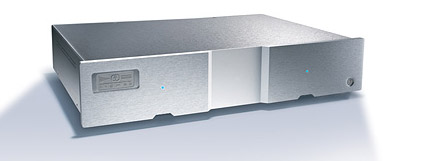IsoTek Systems Sigmas Mains Filter
| IsoTek Systems Sigmas Mains Filter |
| Clean Power Galore |
|
|
|
December 2007 |

Lights On
As we all know, high-end audio has a number of enemy combatants that can adversely affect the quality of the musical source and compromise our aural experience. Invisible anomalies like RFI, EMI, vibrations, standing waves and electrical contaminants that plague AC power lines. But fortunately for audiophiles who are trying to get the most out of their systems, there are a number of products that resolve to clean up the sound without altering the integrity of the original signal. Products that elevate, isolate, absorb, and stabilize; with some registering marginal to very good results, with others showing no promise at all. That’s not to say that some of the after market products that exhibit negligible findings do not work, it just suggests that the designers of the original components accounted for those unwanted aberrations and the ‘tweaks’ might work better within other hi-fi systems. Yet during my 20 year tenure centered on high-end audio I can not think of the last time that I was so enamored and transfixed by a high end accessory, specifically an AC line conditioner. Previous devices that I have auditioned have rendered cumulative results that have been a combination of favorable and not so favorable findings, until now. The products I found so exceptional are AC line conditioners from IsoTek Systems.
Iso-Tech
IsoTek Systems is the brainchild of Peter Dolding and Keith Martin. The company was established in 2001 with the sole purpose of providing clean power for audio and video equipment. The folks at IsoTek feel passionately about producing state-of-the-art products that can be experienced by a majority of individuals. They work very hard developing unique ideas and do a lot of mathematical analysis that is backed up by extensive listening tests, and finally field testing. Once they’re happy with the end results, they calculate the cost to manufacture each item and try to price their products so that they can reach an audience that is as wide as possible.
All of IsoTek’s products are designed and manufactured in England with proprietary technology that is a departure from the traditional way of purifying the line with one or more massive isolation transformers and instead uses smaller individual transformers and a unique set of filters connected directly to each individual outlet. The cornerstone of IsoTek’s product range is that each outlet is isolated from every other outlet using their proprietary Polaris-X technology. In many of their products, the use of independent filters connected to each outlet further helps to reduce cross contamination.
The company’s first products used conventional theories about AC line filtration and required a little bit of manual involvement on the part of the customer. Although a huge success, IsoTek’s engineers didn’t stop there and improved on their previous accomplishments and used that knowledge as the foundation for their next line of products commonly referred to as Generation Two or Gen Two (GII for short). The top of line GII Titan ($3,550.00), a product designed specifically for power amplification, and the GII Nova ($3,750.00), a product that is intended to be used only with source components are fantastic. The GII Sigmas ($2,150.00), is a hybrid, single box solution incorporating features from both the generation II Titan and Nova and I was told that is why the name is plural instead of singular. Even though the GII Sigmas is a scaled down version it is a wonderful unit, a fantastic value for the money and is also the subject of this review.
Clean Power
The GII Sigmas is an attractive, simple to use, plug and play, six outlet line conditioner that is 17.5 inches wide, 3.5 inches high, and a little longer than 12 inches deep. It is handsomely constructed with the outlets on the back of the chassis so that you can also place it on the same equipment rack as the rest of your components. There is a standard 20amp IEC female connector that is used to connect the GII Sigmas to the AC mains in place of the high grade Neutrik PowerCon connector that is used on the GII Titan and GII Nova. Since I loaned out my 20 amp power cords I used the supplied IsoTek Optimum power cord which is also excellent, I might add. The unit sans heavy transformers still weighs a hefty 21 pounds and comes in a choice of colors, silver or black.
There are no meters, buttons or switches to push, just a set of thermo magnetic circuit breakers underneath the chassis that turns the unit on. Two blue LED’s on the front panel above the circuit breakers illuminate when the switch has been moved into the ‘on’ position. Most manufacturers will use a resistor to step down the voltage for this power indicator LED, some will add a diode to stop it from flickering, and the really fastidious may even add a soothing capacitor. LED’s will generate noise, however small. In the Sigmas there are seven components connected to the LED that act as a mini filter. The engineers are so serious about preventing noise from tainting the mains that they have even gone so far as to design a filter for the LED connected to the circuit breaker! Wow!
The breakers on the right hand side of the front panel facing the user must be engaged first. This is the high current side derived directly from the GII Titan using IsoTek’s unique technology called ‘Direct Coupled Design’. Direct Coupled Design uses a number of sophisticated filters, including a shunt, delta, and series filter to clean up the line and if you are interested in a detailed and more technical description I suggest that you take a look at the company’s website.
There are two high current outlets in case you have monoblocks, want to bi-amp or have a tube preamp that draws a lot of juice. Each one is rated at 16 amps and can deliver 1760VA continuously at 110 volts and 3840VA at 240 volts. However, according to IsoTek, “it is possible to pull up to 16,000 watt transients through the design, enough for most amplifiers”.
The medium current side has four sockets rated at 6 amps and delivers 660VA continuously at 110 volts and 1440VA at 240 volts and features the ‘Adaptive Gating’ technology from the GII Nova. This is a filter that has auto-sensing which adapts to the requirements of the load over a 5-10 minute period. With all these amps and volts and watts and filters, I was curious to see what the inside looked like on an actual unit because I only have a photo that shows how it looks with the cover removed. But I was unable to sneak a peek inside because I needed a special tool to unlock the security screw. So I had no choice but to plug it up and get started.
Tek Filtered
The unit that I had in for review had not been broken in and it sounded that way. When at all possible I prefer to evaluate a brand new unit because that way I can relate to what the customer might encounter from start to finish. However I do understand that manufactures cannot always send out a fresh unit and I’ll take my Blessings as they come.
Initially, the GII Sigmas sounded lean and slightly congested; but that was expected. After the second day things slowly began to change and the high frequencies improved considerably and the images started to focus within the soundstage. However, the low end was nothing to write home about and I started to think that this might be another line conditioner that robbed the music of body in the lower registers and I would have an unsatisfactory listening experience.
But after just three days of listening (I used the IsoTek Systems Enhancement CD to speed up the break-in process), the low end not only returned, but erupted with demonstrative proportions! There was tremendous force and throughput of bass information that led me to believe that my woofers circumference had increased greatly from its two 6 1/2 inch drivers to a new set of eight inch dynamos. The modified Acoustic Zen Adagio EXtreme loudspeaker recreates the low end with a taut grip and will reportedly go as low as 25Hz. But two 6 1/2 inch woofers can only move so much air. Yet with the GII Sigmas mains filter cleaning up the line, the amount of low end output increased exponentially and it seemed to come a little closer to the prodigious bass production of my Von Schweikert VR-4 JR’s. These loudspeakers have significantly larger drivers with each one of these loudspeakers using two seven inch bass woofers, and one seven inch midbass driver.
On previous occasions I’ve used power conditioners that have softened up the bass lines, constricted the dynamic flow and reduced the low-end weight and authority. But the GII Sigmas had an enigmatic effect on the performance and significantly improved bass definition and thrust, and provided more heft, a signature quality that allowed me to get closer to the emotional impact of real music, something that I didn’t expect.
What I did expect was for the midrange and the high frequencies to demonstrate outstanding improvement and I was correct in my preconceived notions. Yet once again I was surprised by the sheer volume of change. Anytime the noise floor is lowered via reduced distortion I expect an increase in detail, clarity and transparency. But there was new life and vigor to the presentation. Treble information escalated to new heights without adding any excessive noise. It was clean, precise and overly gratifying to the ear. There was a renewed sense of resolution along with greater transient speed. Small details were unearthed and subtle nuances uncovered. There was a noticeable enhancement up top with crash and splash cymbals sounding so sweet and abundant that I realized that another potential distraction that would prevent the presentation from sounding as real as possible was eliminated.
Midrange frequencies also received a cleansing so to speak. An ever so slight, loosely knit, silk scarf that seemed to be delicately placed over voices as well as instruments was lifted. There was a quieter background not entirely black but dark enough to let subtle cues float freely and uninhibited. Voices, whether male or female, sounded superb without any kind of manipulation. With the GII Sigmas ridding the line of electrical parasites it was like I switched from pentode to triode mode. I experienced a sweet, palpable three dimensional holographic sound that had an undeniable and unmistakably mesmerizing effect on the music.
 Extremely satisfied to this point I decided to pull out a disc that I use to gauge a systems capability to recreate high frequency information. The name of the selection isWe Three by Roy Haynes with Phineas Newborn and Paul Chambers on Prestige/New Jazz Records [OJCCD-196-2-NU-8210]. This is a 1958 recording with Haynes on drums, Newborn on piano and Chambers on bass and if the playback system is not up to the task the top end performance can become shrill and over exaggerated. The first cut, ‘Reflection’ is my ultimate test for clarity and it was immediately obvious that clean power had played a major contribution in the positive outcome that I experienced listening to this song. Roy Haynes vibrant play on drums was free of any strain or unpleasantness. His ride on the high hat had more snap and pop and there was fuller sounds emanating from a quieter background.
Extremely satisfied to this point I decided to pull out a disc that I use to gauge a systems capability to recreate high frequency information. The name of the selection isWe Three by Roy Haynes with Phineas Newborn and Paul Chambers on Prestige/New Jazz Records [OJCCD-196-2-NU-8210]. This is a 1958 recording with Haynes on drums, Newborn on piano and Chambers on bass and if the playback system is not up to the task the top end performance can become shrill and over exaggerated. The first cut, ‘Reflection’ is my ultimate test for clarity and it was immediately obvious that clean power had played a major contribution in the positive outcome that I experienced listening to this song. Roy Haynes vibrant play on drums was free of any strain or unpleasantness. His ride on the high hat had more snap and pop and there was fuller sounds emanating from a quieter background.
 The next disc that I selected is one of my favorite live recordings because not only do I get a chance to hear the recorded version but I also get a chance to hear the real ‘McCoy’ when I get an opportunity to attend church, which is quite often. The name of the recording isShekinah Glory Ministry – Jesus[KING3003A2]. This is a two CD set live recording that has a number of inspirational songs both fast and slow. Again there was an overall improvement in the quality of the music and the soundstage benefited as well. There was better separation between musicians and singers. Micro details intensified, and the flow from soft to loud was executed with tremendous precision. On track number six, ‘Stomp’ there is a powerful war chorus against the wiles of the devil and the intensity level increased substantially to the point that I thought that the amplifiers that I was using had suddenly doubled in current and headroom.
The next disc that I selected is one of my favorite live recordings because not only do I get a chance to hear the recorded version but I also get a chance to hear the real ‘McCoy’ when I get an opportunity to attend church, which is quite often. The name of the recording isShekinah Glory Ministry – Jesus[KING3003A2]. This is a two CD set live recording that has a number of inspirational songs both fast and slow. Again there was an overall improvement in the quality of the music and the soundstage benefited as well. There was better separation between musicians and singers. Micro details intensified, and the flow from soft to loud was executed with tremendous precision. On track number six, ‘Stomp’ there is a powerful war chorus against the wiles of the devil and the intensity level increased substantially to the point that I thought that the amplifiers that I was using had suddenly doubled in current and headroom.
It was a snap to follow individual lines and the volume level of minute details increased as expected but what was once minor background sounds could now be realized much easier and it helped to contribute to the pace and the momentum of the music. So what were once obscure and inconsequential details now became an integral part of the performance. I was also impressed with the GII Sigmas ability to construct a wall of silence in between passages. The GII Sigmas did a fabulous job of conveying a sense of peace and tranquility and also created a beautiful ambient atmosphere for praise and worship during the playback of ballads.
A Clean Finish
The IsoTek Systems GII Sigmas has a marvelous effect on recorded music and is a spectacular piece of equipment. It improves the performance throughout the entire frequency range without upsetting the tonal balance or affecting the tempo. I was amazed at how low-end information was so profound, the midrange is rich with harmonic melodies and I could better define and discern high frequency information. The GII Sigmas is innocuous, which it should be, and lets the original signal pass through unadulterated and allows the upstream components to portray the music with a natural and compelling presentation that sounds ever so life like especially if the source material is a recording of a live event.
It is a product that doesn’t compromise at any level and should add a positive and beneficial improvement to systems of modest expense and also dramatically enhance systems that are substantial in price. The proprietors of IsoTek have been informed on numerous occasions that they could charge a bit more for the GII Sigmas based upon its performance, fortunately for us, they declined.
With the Generation II Sigmas removing a lot of the pollution and unwanted noise from the main AC line I feel I have successfully waged a battle against one of the unsightly evils of high end audio that I mentioned at the start of this review and I strongly recommend that you give it an audition.

______________________
Manufacturer:
IsoTek Systems
IsoTek Systems
Unit 16 Plantagenet House
Kingsclere Park
Kingsclere
Hants
RG20 4SW
Tel: 44 (0) 1635291600
Website: www.IsoTeksystems.com
Price: $2,150.00 USD
U.S Distributor:
IsoTek USA
The Sound Experts
654 South Lucile Street
Seattle
Washington
WA98108
Tel: (206) 762-8383
Website: www.thesoundexperts.com
Specifications:
Number of outlets: 6 standard, unswitched
Mains Inlet: 20amp IEC
Mains Voltage: 100-240V VAC
High current outlets: 16 Amps
(electronic fused)
Watts at 230V: 3680W
Watts at 110V: 1760W
Medium current: 6 Amps
(electronic fused)
Watts at 230V: 1380W
Watts at 110V: 660W
Dimensions: 444mm x 85mm x 310mm (WxHxD)
Weight: 9.5 kg
![]()
Don’t forget to bookmark us! (CTRL-SHFT-D)
Stereo Times Masthead
Publisher/Founder
Clement Perry
Editor
Dave Thomas
Senior Editors
Frank Alles, Mike Girardi, Russell Lichter, Terry London, Moreno Mitchell, Paul Szabady, Bill Wells, Mike Wright, and Stephen Yan,
Current Contributors
David Abramson, Tim Barrall, Dave Allison, Ron Cook, Lewis Dardick, John Hoffman, Dan Secula, Don Shaulis, Greg Simmons, Eric Teh, Greg Voth, Richard Willie, Ed Van Winkle, Rob Dockery, Richard Doron, and Daveed Turek
Site Management Clement Perry
Ad Designer: Martin Perry





Be the first to comment on: IsoTek Systems Sigmas Mains Filter